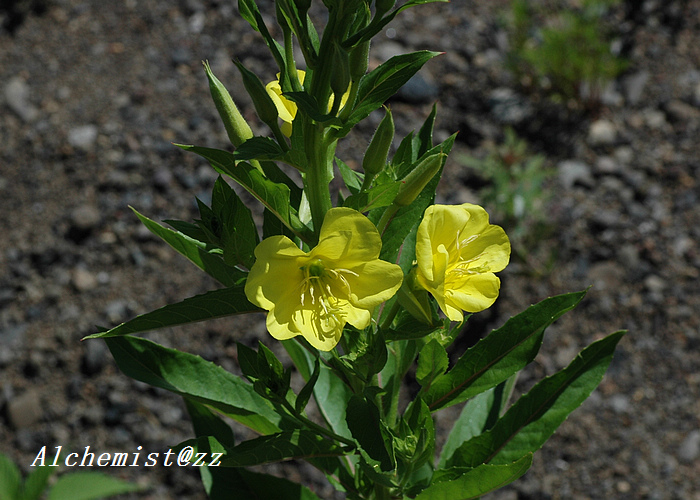- Scientific Name: Oenothera biennis L.
- Ref: Sp. Pl.:346. 1753
- Synonyms: Oenothera muricata L., O. suaveolens Pers., Onagra biennis (L.) Scop.; O. muricata (L.) Moench
- English Common Name: common evening-primrose, evening star, sun drop
- Chinese Common Name: 月见草 yuèjiàn∙cǎo
- Japanese Common Name: メマツヨイグサ [雌待宵草] mematsuyoigusa
- Family: Onagraceae
- Genus: Oenothera
- Distribution: Common in open, disturbed areas; near sea level to 1500 m. Anhui, Guangdong, Guangxi, Guizhou, Hebei, Heilongjiang, Henan, Hubei, Hunan, Jiangsu, Jilin, Liaoning, Nei Mongol, Sichuan, Taiwan, Yunnan [Bhutan, Japan, Kazakhstan, Korea, Kyrgyzstan, Russia; native to E North America; widely naturalized in SW Asia, Europe, Pacific islands (New Zealand), and S South America].
- Photo: 07/14/2008, Mt. Changbai, Jilin
Herbs erect, biennial, with basal rosette. Stems 30-200 cm tall, simple or sparsely branched, densely to very sparsely strigillose and with longer spreading and usually pustulate-based hairs, inflorescence often also glandular puberulous. Leaves green or pale green, with inconspicuous veins, sessile or shortly petiolate; rosette blade 10-30 × 2-5 cm; cauline blade narrowly oblanceolate to elliptic, 5-22 × (1-)1.5-5(-6) cm, base acute to attenuate, margin dentate to subentire, often lobed near base, apex acute. Inflorescence a dense mostly unbranched spike. Flowers open near sunset; floral tube (2-)2.5-4 cm. Sepals 1.2-2.2(-2.8) cm, with free tips 1.5-3 mm, erect. Petals yellow, fading to orange, 1.2-2.5(-3) cm. Anthers 3-6(-9) mm; pollen ca. 50% fertile. Ovary densely glandular puberulous and sparsely villous or with very sparse pustulate-based hairs, sometimes only densely strigillose; stigma surrounded by anthers. Capsules green, narrowly lanceoloid to lanceoloid, 2-4 cm, sessile. Seeds in two rows per locule, brown to nearly black, 1.1-2 mm, irregularly pitted. Fl. Jul-Oct, fr. Jul-Nov. 2n = 14, permanent translocation heterozygote; self-compatible, autogamous. (Flora of China)
